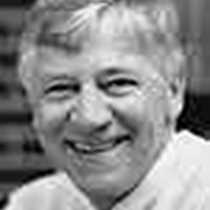Mouth of the Columbia River
Our intrepid group of explorers from the Sea Lion had a busy and most rewarding day. After the usual scrumptious breakfast and a safety drill, we left our dock in Astoria, Oregon and began our activities at the Columbia Maritime Museum. After an hour and a half at that fine facility and an increased appreciation for the history of the Columbia River, its commerce, and the challenges of crossing the bar at its mouth, we boarded buses and headed to Fort Clatsop, where the Corps of Discovery spent the winter of
1805-6.
It was fitting that we were experiencing light rain when we arrived at Fort Clatsop. This inclement weather brought us closer to the realities of the expedition. Lewis and Clark and their party were at the fort from December 7, 1805 until March 23, 1806 and during those three and a half months only had eleven days without rain! We saw a fine film about the Clatsop Indians and their interaction with the Corps, visited the full-scale replica of the fort (a very accurate reproduction, historians believe, because of sketches and dimensions in the Journals that were used in constructing), and spent time in the visitor center bookstore which houses a comprehensive collection of Lewis and Clark literature.
A good, hot lunch back on board the Sea Lion offset the chill of the Clatsop weather. Then the wonderfully fickle climate of the Pacific Northwest surprised us by presenting a beautiful afternoon of sunshine. Part of our group bused and hiked to the Astoria Column, while the majority of the group reboarded a bus for a 30 minute ride to Cape Disappointment, on the Washington side of the Columbia. Named by a British sea Captain in 1788 over his frustration at not being able to find the entrance to the “great river of the West” (the American, Robert Gray, was to achieve this four years later), this state park houses one of the most impressive museums in the entire country devoted to the Lewis and Clark expedition. In addition to enjoying this extremely well conceived and displayed exhibit, a dozen members of our party took a nice hike to another park site that includes a Maya Lin work of art commemorating the expedition and its partnership with Columbia River Native Americans.
Back to the Sea Lion by 5:00 p.m., we left Astoria and began our journey back upriver for more adventures to come. Like our heroes, “we proceeded on”!
Our intrepid group of explorers from the Sea Lion had a busy and most rewarding day. After the usual scrumptious breakfast and a safety drill, we left our dock in Astoria, Oregon and began our activities at the Columbia Maritime Museum. After an hour and a half at that fine facility and an increased appreciation for the history of the Columbia River, its commerce, and the challenges of crossing the bar at its mouth, we boarded buses and headed to Fort Clatsop, where the Corps of Discovery spent the winter of
1805-6.
It was fitting that we were experiencing light rain when we arrived at Fort Clatsop. This inclement weather brought us closer to the realities of the expedition. Lewis and Clark and their party were at the fort from December 7, 1805 until March 23, 1806 and during those three and a half months only had eleven days without rain! We saw a fine film about the Clatsop Indians and their interaction with the Corps, visited the full-scale replica of the fort (a very accurate reproduction, historians believe, because of sketches and dimensions in the Journals that were used in constructing), and spent time in the visitor center bookstore which houses a comprehensive collection of Lewis and Clark literature.
A good, hot lunch back on board the Sea Lion offset the chill of the Clatsop weather. Then the wonderfully fickle climate of the Pacific Northwest surprised us by presenting a beautiful afternoon of sunshine. Part of our group bused and hiked to the Astoria Column, while the majority of the group reboarded a bus for a 30 minute ride to Cape Disappointment, on the Washington side of the Columbia. Named by a British sea Captain in 1788 over his frustration at not being able to find the entrance to the “great river of the West” (the American, Robert Gray, was to achieve this four years later), this state park houses one of the most impressive museums in the entire country devoted to the Lewis and Clark expedition. In addition to enjoying this extremely well conceived and displayed exhibit, a dozen members of our party took a nice hike to another park site that includes a Maya Lin work of art commemorating the expedition and its partnership with Columbia River Native Americans.
Back to the Sea Lion by 5:00 p.m., we left Astoria and began our journey back upriver for more adventures to come. Like our heroes, “we proceeded on”!




